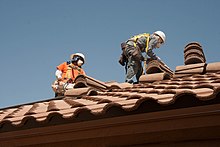Roofer
 | |
| Occupation | |
|---|---|
Occupation type | Vocational |
Activity sectors | Construction |
| Description | |
| Competencies | Heights, patience, steady hand, ability to read plans, physically strong |
Education required | Apprenticeship |
Fields of employment | Construction |
Related jobs | Carpenter, Electrician, Plumber, Welder |

A roofer, roof mechanic, or roofing contractor is a tradesperson who specializes in roof construction. Roofers replace, repair, and install the roofs of buildings, using a variety of materials, including shingles, bitumen, and metal. Roofing work can be physically demanding because it involves heavy lifting, as well as climbing, bending, and kneeling, often in extreme weather conditions.[1]
Throughout the world

In Australia, this type of carpenter is called a roof carpenter and the term roofer refers to someone who installs the roof cladding (tiles, tin, etc.).
In the United States and Canada, they're often referred to as roofing contractors or roofing professionals. The most common roofing material in the United States is asphalt shingles. In the past, 3-tab shingles were used; nowadays, "architectural" or "dimensional" shingles are becoming very popular.[2]
Depending on the region, other commonly applied roofing materials installed by roofers include concrete tiles, clay tiles, natural or synthetic slate, single-ply (primarily EPDM rubber, PVC, or TPO), rubber shingles (made from recycled tires), glass, metal panels or shingles, wood shakes or shingles, liquid-applied, hot asphalt/rubber, foam, thatch, and solar tiles. "Living roof" systems, or rooftop landscapes, have become increasingly common in recent years in both residential and commercial applications.[3][4]
In the United States, regulation of the roofing trade is left up to individual states. Some states leave roofing regulation up to county-level and municipal-level jurisdictions.[citation needed] Unlicensed contracting of projects worth over a set threshold may result in stiff fines or even time in prison.[5] In Oklahoma roofers are required to meet insurance and roofing license guidelines. Roofers are also required to show their license number on their marketing material.
The United Kingdom has no legislation in place that requires a roofer to have a license to trade, although some do belong to recognized trade organizations.[citation needed]
Types of roofers

There are four main types of roofers: shinglers, who primarily install shingles, shakes, tiles, and other nail-on products on roofs with 5:12 pitches or above; metal roofers, who focus on metal panels; single-ply or "flat" roofers, who focus on roofs such as single-ply or foam roofs; and "hot" roofers, who work using tar-based products. It is not uncommon, however, for companies to have their roofers service multiple styles and types of roofing; and certain manufactures will allow only pre-approved installers, thus making these four roofer types limiting. As per the application areas, roofing contractors can be categorized as Industrial or commercial roofers, Factory Shed roofers, Residential Roofers, Commercial roofers. Based on the types of the materials, roofing can be classified as terrace roofing, metal roofing, polycarbonate roofing, steel roofing, PVC roofing, skylight roofing. Pre-engineered companies installs roofing.
See also
References
- ^ "Roofers : Occupational Outlook Handbook: : U.S. Bureau of Labor Statistics". www.bls.gov. Retrieved 2018-06-22.
- ^ "Architectural Shingles vs 3 tab Shingles". roofpedia.com. Retrieved 2018-08-14.
- ^ See List of commercially available roofing material
- ^ "How Roofing Materials Work". HowStuffWorks. 2009-01-09. Retrieved 2018-08-14.
- ^ "Roofing Contractor". labormarketinfo.edd.ca.gov. State of California. Retrieved 18 February 2015.
